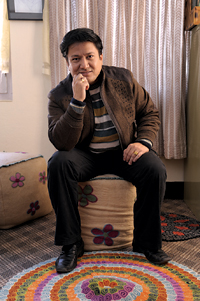Amogh Dhakhwa’s office is a zoo. Literally. There are giraffes and penguins on his desk, an ant-eater and an alligator on his sofa and a smug looking cow sitting on his coffee table. Luckily, each animal is only a few inches tall and made of felt, for if they weren’t, the room would be a veritable madhouse. The felt animals, which are toys, puppets, and Christmas decorations, are just a few of the handicraft items that are a part of Dhakhwa’s company, Nepal Craft Gallery.
 Nepal Craft Gallery deals almost solely in felted goods, which, like the zoo of animals populating the office, are colorful, handmade creations that have personality and charm. There are a number of companies in Nepal that create felted handicrafts, many of which are exported to the United States and Europe. If you were to check the tag on a felted good in the U.S., Western Europe or Japan, you’d likely find that the item was handmade in Nepal.
Nepal Craft Gallery deals almost solely in felted goods, which, like the zoo of animals populating the office, are colorful, handmade creations that have personality and charm. There are a number of companies in Nepal that create felted handicrafts, many of which are exported to the United States and Europe. If you were to check the tag on a felted good in the U.S., Western Europe or Japan, you’d likely find that the item was handmade in Nepal.
Dhakhwa’s business was started by his father in 1971 when the company initially sold Tibetan thangkas and singing bowls. With changing times and market demand, the company slowly shifted from traditional, regional handicrafts to colorful felted goods.
Nepal Craft Gallery, which directly exports 95% of their products, has an abundance of felted products available, including carpets, coin purses, handbags, slippers, Christmas ornaments, toys and hand puppets. Each item is made of wool, which mainly comes from New Zealand, but the final product is made with a wool derivative called felt. A unique process to create felt from raw wool is completed by the Nepal Craft Gallery workers.
“Most of our items are made by women, some from Kathmandu and some from villages,” explained Dhakhwa. “They felt everything by hand, with soap and water.”
Felt fabric is made from wool that becomes matted when moistened under pressure and heat. Workers begin with dyed wool, which is the raw material for all felted goods. They then put soapy, hot water on the wool until the entire mass is saturated. After the wool is completely wet, they will work the fiber by hand, similar to how a baker would knead a loaf of bread. When the wool is sufficiently hand-worked, it is rinsed, pressed and dried. After the drying process is complete, the wool will have turned into colorful and cozy felt, which can then be cut and sewed into ornaments, clothing and toys.
“It is a very in-depth process,” Dhakhwa said, as he held up a rainbow-colored handbag made by one of his employees in the Patan-area factory. “In one day, one person can make only three or four bags.”
For more information about felt handicrafts in Nepal please visit: www.feltsofnepal.com.











